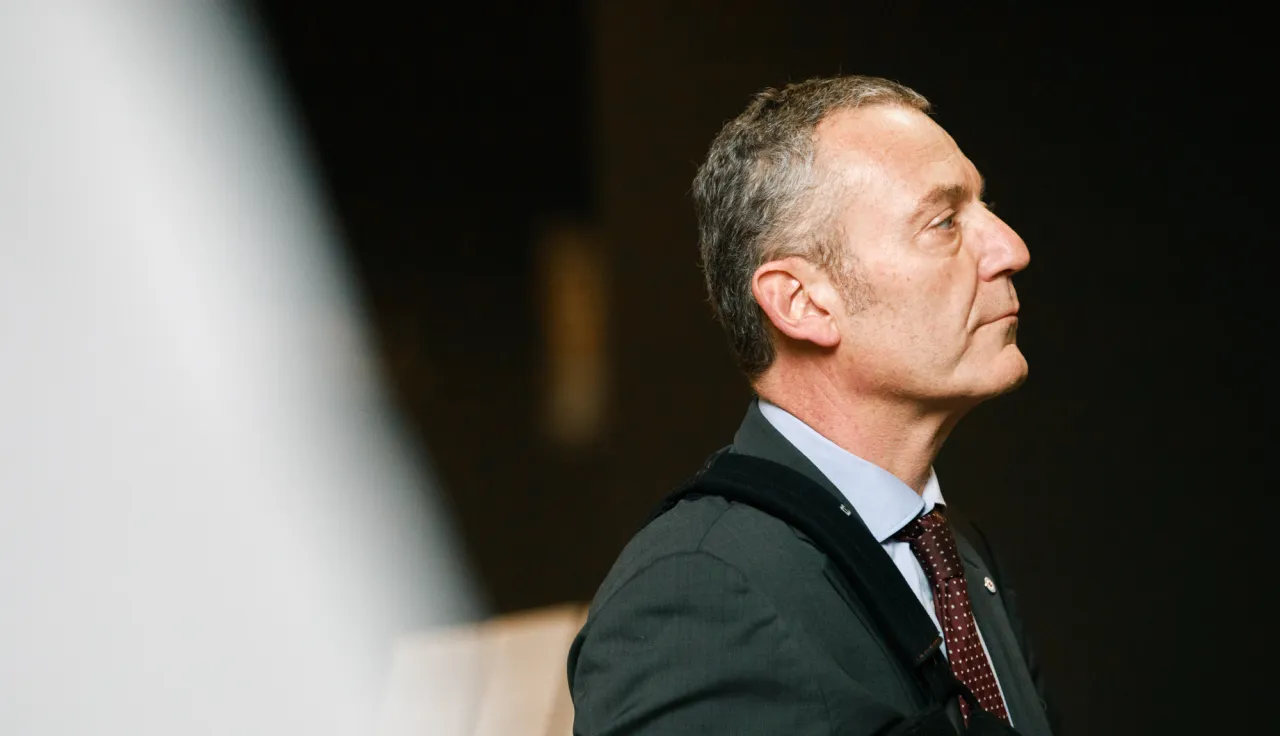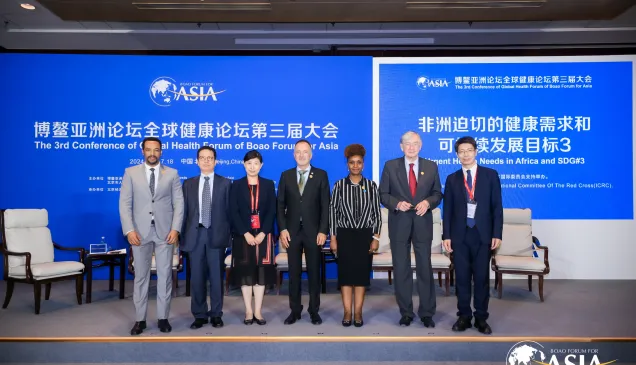A journey featuring humanity in war - twenty years of my ICRC experience

On the morning of 3 November 2016, Pierre Dorbes, head of the ICRC's Regional Delegation for East Asia, visited the Humanity in War exhibition in the Capital Museum. With no heating in the Capital Museum, the B1 exhibition hall felt gloomy, maybe even a little bit colder than outside.
During his visit, Pierre suddenly stopped in front of one of the exhibits, stared at it through the transparent acrylic cover in meditation for a long time, having no intention of leaving. What he saw was a sky-blue bullet-proof vest worn by an ICRC representative in Zenica during the Bosnian War. His solemn action attracted my attention. When we came back to the office, he told me, after my series of questions, the story of how war changed the life of this vigorous young man, who turned 25 during that turbulent time.
The story started 23 years ago, when a French NGO sent the then 25-year-old Pierre to the battlefield in Zenica, Bosnia. Zenica is the centre of the iron and steel industry in Bosnia and Herzegovina, located on the Bosna River, a tributary of the Sava River, 60 km southeast of Sarajevo. He was mainly responsible for sending medical supplies and providing medical assistance. This was the first time he had been caught up in a war.

Located in the centre of the European continent, Zenica is only around an hour's flight from his home city, Paris. He used to talk about war with his parents, sometimes discussing WWII, which they had experienced. However, when he arrived in Zenica, he discovered that the situation there was not "bad", but "terrible". A voice kept echoing in his mind, "War is real. It doesn't just exist in books, it's not a remote topic for discussion. It's really close!"
The young Dorbes realized for the first time that war was happening on the doorstep of Western Europe. Peaceful Paris was only two hours away from the battlefield! "This bullet-proof vest and helmet were a daily necessity of my work!" This was the equipment that unarmed humanitarian workers relied on to protect themselves in a fierce and dangerous environment like that, so that they could help more people in need. After experiencing the war in person, I felt much closer to my parents, and completely different when I discussed war with them."
As he was the youngest son in his family, Pierre's parents were understandably worried when he decided to abandon his peaceful life. "At that time, there was no mobile phone, no Internet. I could only contact my family every two to three months by satellite phone, which was quite expensive." After being concerned about his safety for a year, his parents finally saw him return safely with his work done. But to their surprise, Pierre applied to join the ICRC. "It was lucky that my application was approved. My parents were really supportive. They believed that this was an excellent experience, which could provide help to people in need."
"During my shocking experience on the battlefield of Zenica's, we had cooperated a lot with the ICRC. I saw how they worked. What I heard and felt inspired me to join them." He has devoted himself to this work for the last 20 years.

In 2004, 10 years after the Rwandan genocide, the situation was still tense, with prisons packed with prisoners - most of them convicted of genocide. Pierre was sent for a two-year mission to Rwanda, where he visited people in prison. His main duty was to provide food, medical services and to ensure the detainees' safety. "This is our humanitarian work. They deserve humanitarian treatment because they are human beings, regardless of their crimes. As ICRC representatives, our main responsibility is to safeguard human dignity. Sometimes I may ask myself if it's right to help these people, and my answer remains affirmative. The ICRC helps those in need without judging."
In the exhibition hall, there is a long corridor where visitors can experience the development of war over the last century through objects, videos and photos. At the end of the corridor, there is a worn teddy bear with countless holes, found after the war, which reminded him of another story about a teddy bear.
In the winter of 2007, in Latin America, guerrillas imprisoned a woman and her child in the jungle. After much effort, the guerrillas agreed to release them, and the ICRC assisted in this release operation. As they prepared to transfer the two, the ICRC provided clean clothes and a hygiene kit for the woman. But what about the child? Pierre thought that the child also needed something to show that he was free, and a teddy bear came into his mind! He wanted to give the child a teddy bear for him to play with and to help him return to a happy childhood. But it was late, and the shops were closed. There was nowhere for Pierre to buy a toy. It suddenly occurred to him that his son had one. So he rushed to his home, persuaded his son, and brought his son's teddy to the kid who had just been released. His son said "Although I like it very much, you can take it. I believe he will like it too!"
As it happened, Pierre did not get to witness the scene of the child being saved and carrying the teddy, since the transfer was delayed for political reasons. But this tiny, beautiful humanitarian gesture made me feel warm and calm. Certain supplies are necessary amidst the cruelty of war, but I believe that the toy representing freedom is much more significant. Isn't this the power of humanity?"

Today, in the exhibition hall, we came cross a group from the Red Cross Society branch in Chifeng, Inner Mongolia. Everyone in the group came to shake hands and had a photo taken with Pierre. We joked that he was mainly responsible for shaking hands and taking photos.
Pierre did not say anything. Instead, he took out his wallet from his pocket and showed us his blue ICRC Mission Paper, and his ICRC badge, which every ICRC delegate must wear when he is on a battlefield, in a military camp or during visits to prisons. "Wherever I am, I take my mission paper and badge with me, every day," he said to me, looking serious. "I now wear a suit for my daily work, but deep in my heart, I'm not an official in an office, but a humanitarian worker wearing blue jeans, a bullet-proof vest and a helmet"!
He fell silent, and his mind seemed to be back on the battlefield. In my mind's eye, I see him on the front line, following his passion and striving to be the best humanitarian worker he can be.
"This exhibition awakens lots of old memories for me. I hope many visitors will come, see and enjoy!" Pierre concluded.


